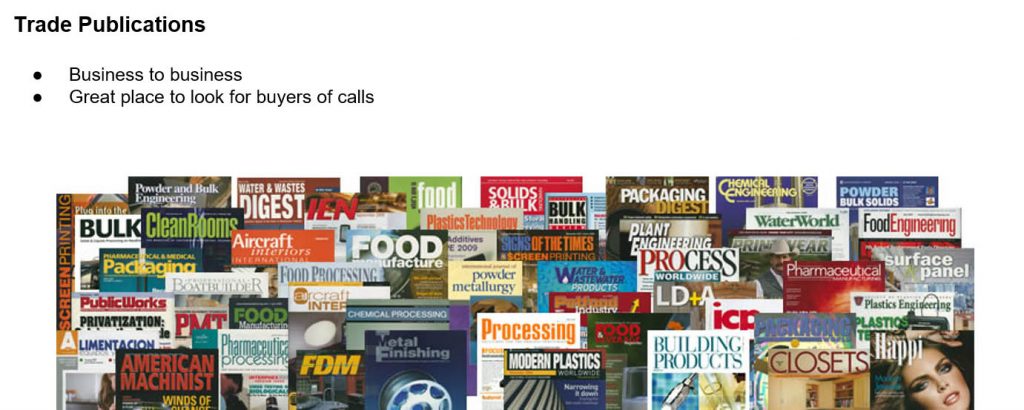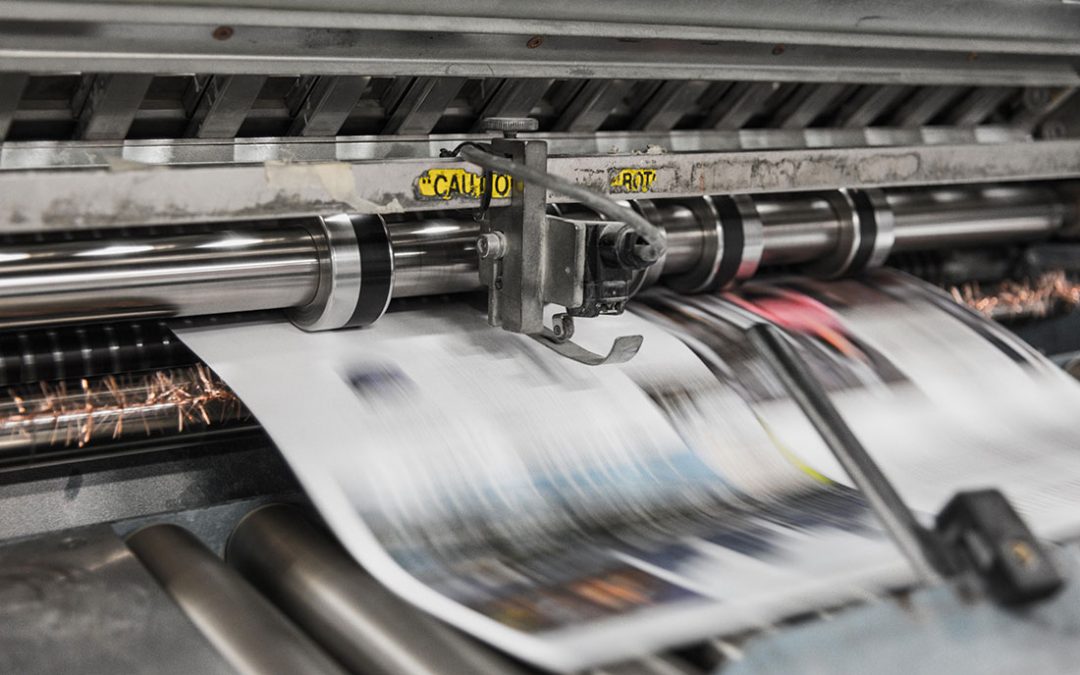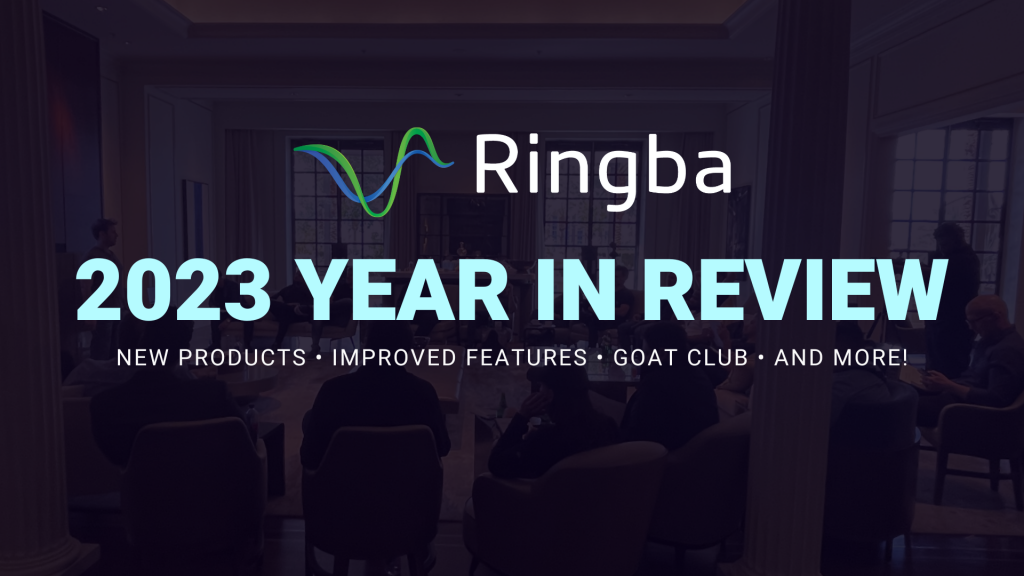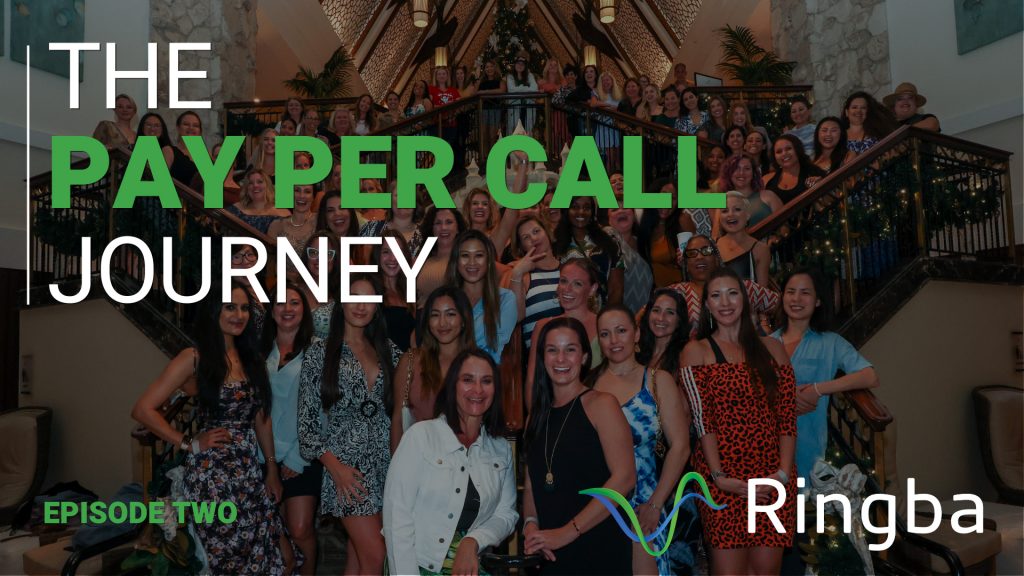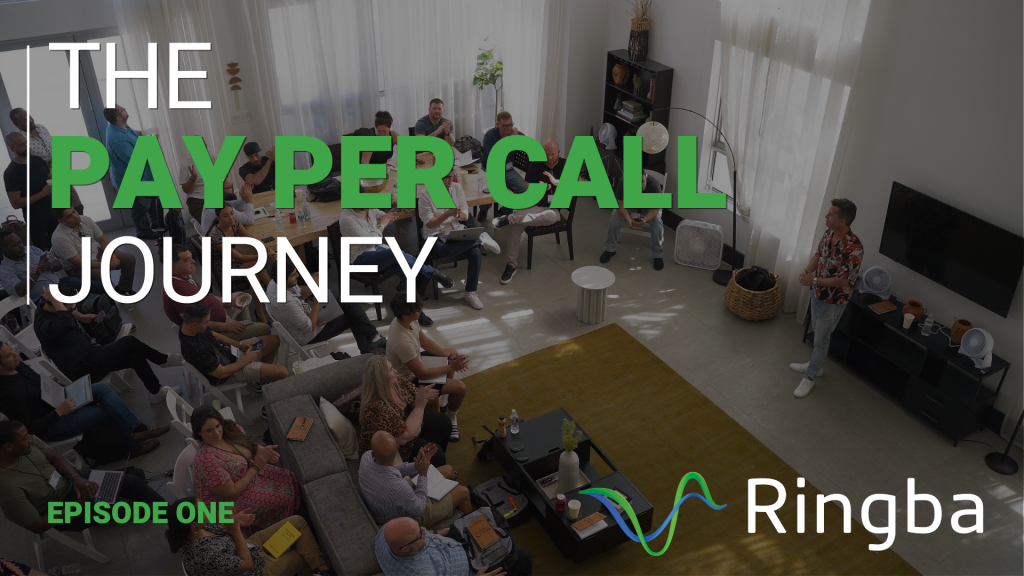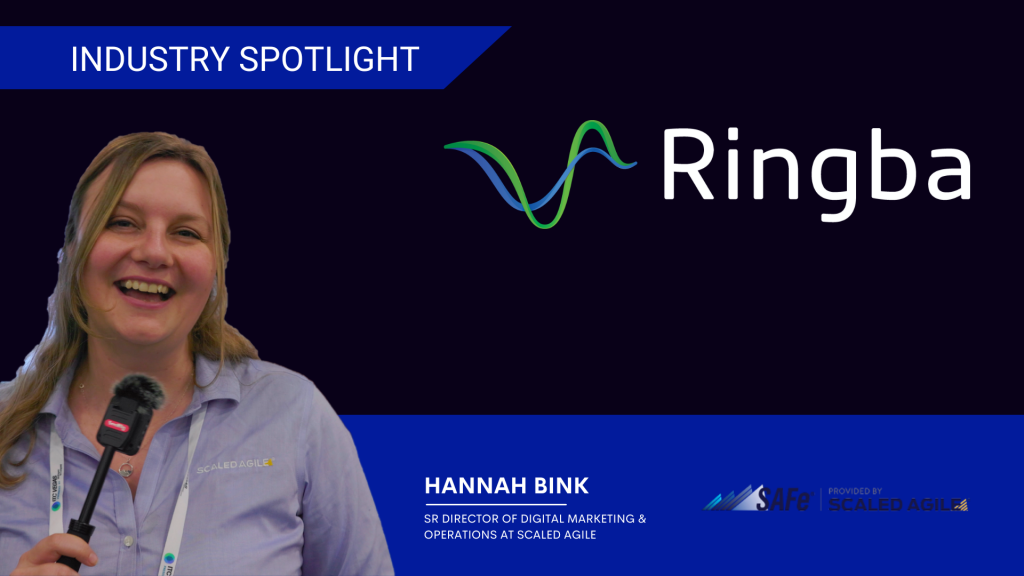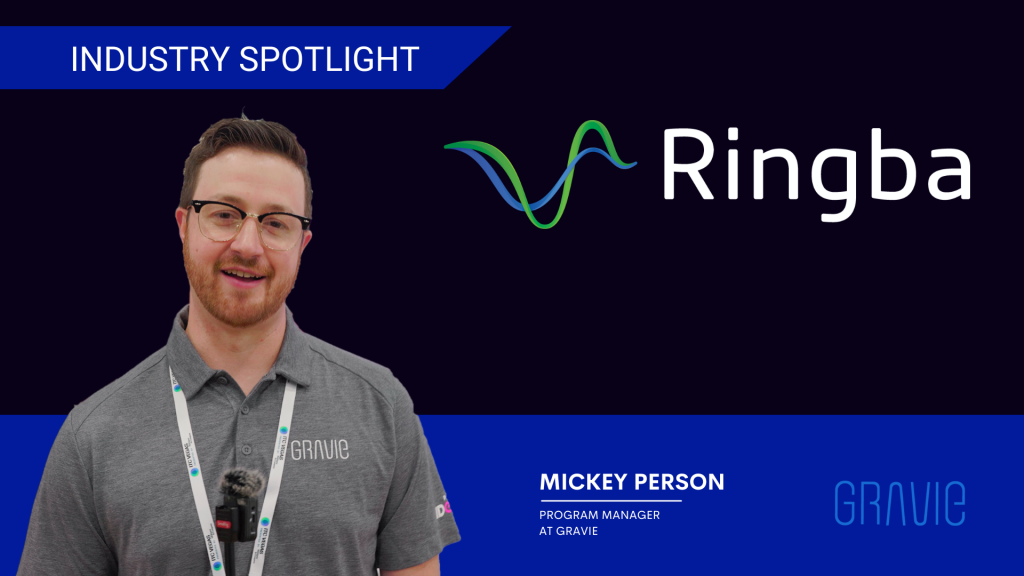Learn how to use Print Advertising campaigns to generate inbound phone calls using magazines, newspapers, direct mail, local circulars and more.
Contents:
– About Print Advertising
– Pros and Cons of Print Advertising for Pay Per Call
– How Print Advertising Works
– How to Produce a Print Advertisement
– Copywriting for Print Ads
– Choosing Your Market
– Choosing Your Placement
– Negotiating with Publications
– Types of Print Advertisements for Pay Per Call
About Print Advertising
Surprisingly, print advertising is massive, and it encompasses all different types of mediums, newspaper, direct mail, magazines, local circulars, flyers, directories. There’s tons of it, and it drives trillions, plural, trillions of dollars in global sales. Print advertising is in every country in the world and is a massive opportunity because a lot of people have forgotten about print advertising.
Newspaper ad revenue is declining a bit. Subscription rates are falling because a lot of those advertisers are moving to digital media, but some of the returns you can get in print advertising are significantly better than you can ever hope to achieve with online advertising when done correctly. We need to talk about this medium. Furthermore, there are not a lot of pay-per-call ads in print, not in the same way you’ll see them on the internet.
It may be shrinking a little bit right now, but it is around to stay. It has the sticking power of an entire century behind it. That, to me, is an exciting opportunity. When it comes to direct mail, if you do direct mail properly and you target the right audience, it can produce 1,000 percent plus returns. Those numbers aren’t exaggerated. They’re not crazy. I dialed them back a little bit for this presentation, but direct mail houses that know what they’re doing and do it well, achieve a massive return on their investment. Direct mail typically has 37% higher response rates than email, and email is undoubtedly cheaper and easier to deliver. But that doesn’t mean that people don’t want mail. It doesn’t mean that people don’t buy out of mail because if people didn’t buy out of their mail, they wouldn’t open it. People wouldn’t be able to send it, same for email.
Direct mail is still an exciting opportunity. It just requires that you learn a different medium to reach people. Then newspapers, newspapers reach 30 million people in the United States every day. They reach more than 10% of the adult population daily. People that read newspapers are typically more well-to-do. They’re going to be of a higher demographic that allows for purchasing. That’s an exciting opportunity as well. I don’t mean that they’re just for rich people, I mean that they’re for the middle class. The perfect market to reach in the United States. Newspapers still bring in almost 20 billion dollars a year in annual advertising revenue. If we’re talking about a pay-per-call campaign, I think you can see very clearly that you can find room for it in 20 billion dollars of revenue. That’s a pretty big market for you to go carve off little pieces off and create pay-per-call campaigns.
Pros and Cons of Print Advertising
What are the pros and cons of print advertising for pay per call, specifically, for someone that’s never done any print advertising?
Pros
– Cheaper placements than other real-world advertising
– Easy to test and modify advertisements
– Virtually endless amounts of publications
– Can be very high ROI
– Extremely low likelihood competitors will copy your work
Cons
– Takes time to distribute your ads
– Long testing cycles
– A large amount of research is required
– Requires lots of phone numbers
– Needs lots of business development
– Can’t pause your campaign
How Print Advertising Works
The first thing you’re going to do is research your publications. You’re going to want to try and figure out what publications are going to reach the same audience that your campaign is going to work in. If it’s medical devices and you need older people, what publications are older people reading? If you’re selling a product that’s auto insurance related, what demographic group do your best customers fall into? Then we’re going to want to figure out which types of publications we want to go for. If you’re advertising to men, a cosmopolitan magazine is probably not the best choice. Once we figured out a few publications, and I would highly recommend coming up with five that are potentially interesting to you, contact the publication for rates. They may have their media kit like American Angler over here, and they are the fly fishing authority. You’re going to want to contact them. You’re going to look at their media kits, but by calling them, you’re going to find out if they’re running any specials or if they have any deals or if any placements are cheaper.
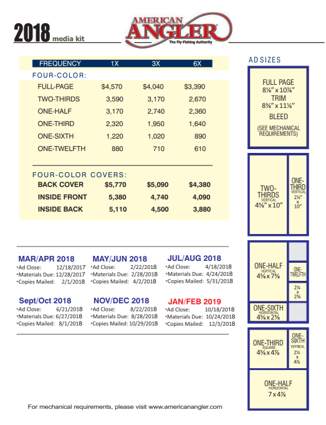
These media kits that they put out there is essentially the rack rate, the street payout of print advertising, and no one ever wants to pre-payout. You don’t want to pay the price that they advertise to everyone; you want to call them and generate a relationship with the account rep and get rates. For instance, if they’re having a hard time selling the back cover, they’re going to discount it for you. If they’re having a hard time filling certain spots, they’re going to discount it and will say that they’re running a special on those rates. But what that means is, no one’s buying this publication or placement, so we’re willing to sell it to you for less. That’s what you’re looking for when you’re testing. You’re going to want to ask the publication representative for the circulation numbers.
How many people are getting the circulation on a daily, weekly, monthly basis? What their circulation is? What the print schedule is, do they do a monthly, do they do a quarterly, is it daily, whatever? Then you’re going to want to ask them what the demographic information is for their audience. They have that information, and it is fascinating. You should ask for it. They will tell you the percentage, men, women. The percentage of interest groups, the average household income of their readership, all this type of stuff. The more niche you get, the more effective the advertising’s going to be because people don’t just walk through a bookstore and then pick up a copy of a special interest magazine on a Tuesday thinking, oh, maybe I want to get into that.
When you have a loyal viewership and readership, they are loyal to the publication and are more likely to buy from the advertisers that also support the publication. That’s my point. Next, we’re going to want to negotiate for placements. We’re going to talk about that a little later, but always negotiate or try and figure out a way to not pay rack rates. We don’t want to pay rack rates, all right? It’s not a good thing to do.
Then we’re going to finalize our placement. We’re going to sign a contract, we’re going to pay the bill, and then we’re going to get flight dates. What are the dates that my ads are going to show up in print? If it’s a monthly magazine, you’re probably going to get one placement. If you’re going to buy a monthly, a contract for one month and then it will go out, maybe not this next month, but the one following. It all depends on what they have available and what their print and flight dates are. You’re going to want to get print specifications from the publisher. You’re going to want to get a print deadline for the publisher, and that means that you don’t turn in your artwork before it doesn’t go into print. Sometimes they have penalties for that. You want to make sure you get them the artwork early so their team can review it because if there are any issues, and we sent it to them late, well, it’s going to print, and that’s a problem if it’s wrong.
We’re going to want to write copy and create an advertisement, and we’ll talk a little bit more about that, and then we submit it to the publisher for print as early as possible so we can get their feedback and make sure everything’s okay. We review the results at 30, 60, and 90 days. You’re going to want to talk to your rep about distribution. Like how long does the advertisement stay on the shelves or the publication? Excuse me, stay on the shelves. If it’s a quarterly one, that same magazine might stay on the shelves in Bookstores and magazine shops for three months, or maybe even four. It all depends, and you’ll want to ask them for that so that you can adequately review your results.
How to Produce a Print Advertisement
This may seem a little scary for those of you that haven’t done it. I want you to know that it’s not at all complicated. It’s pretty close to child’s play, and it isn’t that expensive. You have to know what you want. If we’re going to do a classified ad, there is no producing of a print advertisement. You write your copy, you put your tracking number in it, it has a call to action, you’re done, and that’s it. But if you’re going to do a sweet ad for genes that won’t bind your legs, like Chuck Norris Right here, in cowboy boots no less, you are going to need to find a designer to do that for you. It’s not hard to do. You can go on Upwork, Fiverr, make a LinkedIn post, go to design forums. There’s literally like hundreds of outlets that you can find people to do this for you and Craigslist.
You don’t need to spend any money to find your print designer. You’re not going to hire him first full time if you’re new. Even if you are going to do this regularly, you don’t necessarily have to hire him full time. Work with them first and see how good they are. I highly recommend Upwork. It’s an excellent resource for this type of thing. You’re going to find people with experience; you can look through their portfolio and see if they’ve done a nice job laying out ads for other people. You’re going to want to look at the formatting requirements and the specifications and the bleed from the publication. The publication, they do print for a living, they’re going to give you precise requirements for your app, and those are not negotiable, and you need to make sure they’re perfect.
Most of the time, it’s going to be 300 DPI, which is dots per inch. Most websites and most graphics on the internet are done at 72 dots per inch. You’re going to need a much higher resolution file for print. It’s essential that you get someone who has print experience so they know this and they don’t screw it up. But it’s super easy to find someone that has print experience on Upwork or these other places, and you’re going to review their portfolio, so you will know they’ve done it before. You also want to be aware that CMYK versus RGB is a big deal. If you hire someone who’s a graphic designer who makes websites and doesn’t have print experience, they may screw this up, and that’s a big problem. These two different color tights print differently, and if you send your magazine or your publication on RGB file and they need CMYK for prints, they’re going to convert that RGB to CMYK.
What you’re going to get is an ad that’s got distorted colors. It’s going to look weird, and it’s not going to get the job done. You want to make sure that whatever your file is in, is precisely what the printer needs to produce your advertisement. They’re going to give you specifications for this, but don’t just blow off those specifications. Read them, even if you’re not going to be the guy doing the work, read them, so you understand it. We do a lot of print at Rainbow. We print flyers; we print apparel, we print spiffs for our customers. We even had plain cards printed. The first thing I did with the marketing team every single time when I taught them to do this, reviewed the print specifications with the team so that they knew that different types of printing have different specifications. We never have issues cause they always read the manual.
Make sure you get this correct because you do not want an ad to go out with your brand on it wrong. Makes you look terrible. If you’re going to use a print designer on like Fiverr or something super cheap, make sure they don’t hold your source file hostage. Make sure you’re going to get an AI, an EPS, a PDF, or a PSD. All right. Do not settle for a JPEG, or a GIF or something, a PNG from your contractor because what they’re doing then is holding your source file hostage, and then you can’t repurpose it later. You need to make sure you get the actual source file for your advertisement in whatever they use to make it.
Most of the time, it’s going to be an illustrator file or a Photoshop file, which is an AI or a PSD. That’s what you want. If you have those, you can make your JPEGs and export them, but you want the source file. Otherwise, you can’t edit.
Copywriting for Print Ads
For print, this can be complicated depending on what you’re going to do, and it’s a vast field, and so it’s impossible for me to run you through how to do this for every ad type in this lesson. But I want you to think about two different ad types. We’re going to call them short form and long form. What that means is, are we going to do an ad like this example here, which is long form or are we going to do a classified ad, which in short form just a sentence or two or a few words?
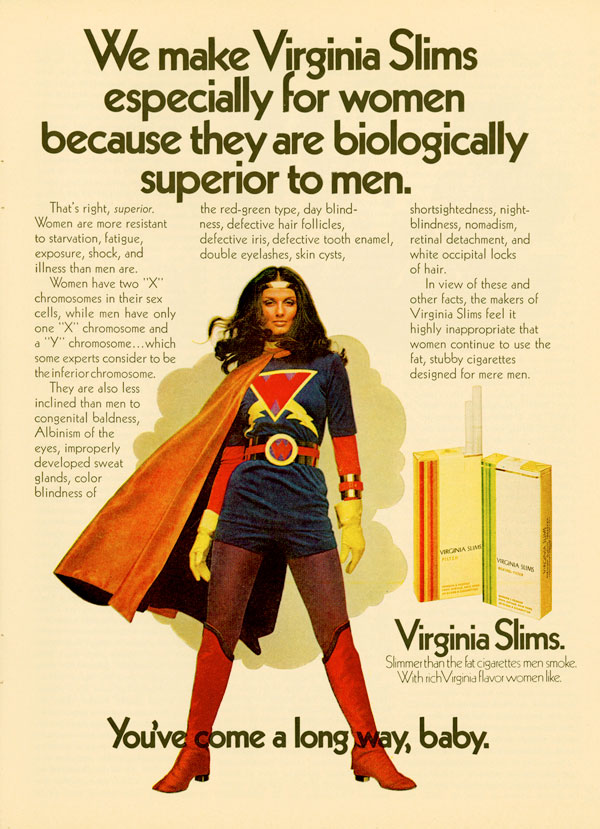
This is typically going to be placement driven, and so the size of the placement in the magazine or the newspaper or whatever is going to drive what the advertisement can be entirely. This one of the example is a long format that’s a half page in the magazine, so this is an expensive advertisement. If you’re testing, you’re probably not going to go there. But long-form advertising is highly effective when you do an excellent job with it and depending on your audience if they’re an older audience, they’re going to appreciate the long forms. You need to understand who you’re marketing to, what your budget is, what size of placement you’re going to do before you decide to do it. The reason I chose this ad, even though it’s old is that it’s ingenious. It’s an incredible advertisement, and I’m going to read it to you, and then we’re going to talk about what they did and why.
They say, “We make Virginia Slims especially for women because they are biologically superior to men.” Then they have the khaki superhero chic, which is fantastic. She has that condescending air of superiority on her face, which is the perfect image. They want the woman to identify with other women that are reading this. When men read this, and they ignore it, but men aren’t the market, so it doesn’t matter. They say, “That’s right. Superior women are more resistant to starvation, fatigue, exposure, shock, an illness than men are. Women have two x chromosomes and their sex cells. Well, men only have one x chromosome and a y chromosome, which some experts consider to be the inferior chromosome. They’re also less inclined than men to congenial baldness. Excuse me, congenital baldness, albinism of the eyes, improperly developed sweat glands, colorblindness, and so on.”
“The red, green type, day blindness, defective hair follicles, defective virus, defective tooth enamel, double eyelashes, skin cysts, short night sidedness, night blindness, nomadism, retinal detachment and white occupational locks of hair.” Given these other facts, excuse me, given these and other facts, the makers of Virginia Slim feel it highly inappropriate that women continue to use the fat stubby cigarettes designed for mere men. Virginia Slims, slimmer than fat cigarettes men smoke, with Rich Virginia flavor women like, you’ve come a long way, baby. This ad’s funny, and it’s a lot to read, but what they’re doing here is they’re making loyal customers. They’re making dedicated, loyal customers and they’re appealing to half of all smokers, women. When women get their packet, Virginia Slims that are longer and slimmer, they feel superior to men.
They pinned women against men, which they are just natively in a lot of situations. It fits. That will cause people to buy. If you haven’t read our lesson on how to use emotions to make compelling sales arguments, please take a look at that class because we go very much into detail on how to actually design and execute campaigns like this. But typically, people buy when they feel, they feel things like fear of loss, or urgency, or the Jones effect, which is, my neighbor got a new lawnmower, then I have to get a new lawnmower. It’s imperative that you write your advertisement to make people feel. You do that with words that resonate with them.
In a nutshell, what happens when you read words that trigger emotions, you had a similar feeling at some point in your life that those words represent. That’s why this works because you’re going after large groups of people and their connected experience. Even though this isn’t a pay-per-call ad, I have to remind you that when you copyright your ad, call now is your best friend. Please use a CTA, a call to action. Tell people what to do. Call now, call immediately. Pick up the phone, dial this number and call now before it’s too late. We have a limited amount of people we’re accepting into this program, so please again, call now. Tell them twice. Tell them three times, but at least do at once, please.
Choosing Your Market
What we want to do after we’ve written our ad is to understand our target audience. Are they male, are they female, what’s their age range, what’s their income level and their interest profile. We want to do this in exactly the way this slide is here. A straightforward bulleted list so that when we talk to add reps, we can tell them what we’re looking for and what their coverage is. Where is your buyer coverage as well? If you have buyers that can only take calls from specific states, you need to make sure that your print advertising is only targeting those geographic regions as well. The great news is with print when you’re talking to your buyers, you tell them, hey, we’re running an ad, and we’re going to do it in the Kansas City Metro area.
I want no area code restrictions on these calls though because they’re in print. People have to physically be located in Kansas City to see the ad with the number in it. You get them to bypass the geographic restriction by area code on a print campaign. You get full coverage and full representation of the audience in there. A lot of buyers, for instance, they only buy by area code, which is not the smartest thing to do because 35% of area codes are incorrect. Like my area code is for Michigan where I grew up, and I no longer live there. If you filter me by area code, it doesn’t do you any good. 35% of people are like that. The cool thing about print is, you know the geographic area it’s going in and then you can go to your buyers and say, I want a non restricted phone number so that I can send you all the callers from this area because they came from print, you’re going to need a good relationship for that. But it’s a way to add about 35% to your qualified call camp.
Choosing Your Placement
This is highly budget dependent. You’re not going to do half page magazine ad like Dharma did here if it’s your first scope. If I were you, I would be looking for the cheaper options to get your feet wet, if you’re new. I’d be looking at classified ads and newspaper ads that are small segments and small percentages of the page, an eighth page or even the 16th page. When you get into the bigger ones, they get much more expensive. It also gets much more costly when you go into color versus black and white. Newspapers, black and white, it’s much easier to design. It’s cheaper on them to print, so they pass some of that savings on to you.
But you can also request color printing in some newspapers. That’s a great way to do it too because if you’re reading a black and white newspaper and you fold the page over, and there’s a color ad, even if it’s one 16th of the page, the color makes it pop. You want to understand your medium. You want to understand, in a newspaper what their capabilities are, the price differences and what your ads are going to look like on the page. Do they only allow one color ad per page, or do they let everyone to do whatever they want? These are questions you’re going to have to ask your ad rep, and they can explain to you entirely what your options are. You want to specifically ask them, what are my print options in a newspaper? What can I do? What are all the placements? Which placements are exciting? Which one sells the best? Why do those placements sell the best?
That’s the key. You want to know why? What are some of your longstanding advertisers buying regularly? Tell me more about what campaigns have been running in this newspaper for years even. Not just months, but years. Because if it’s running for years, you know it’s most likely either a branding campaign or extremely profitable for them. They’ll tell you; they’re not going to be like, I can’t tell you what ads are running in the newspaper. Because for them, that’s dumb. You can buy a copy of the paper. You should, if you’re local, buy it. If you’re not, buy it online. If you can’t buy it online, put a post on Craigslist that says you’ll pay someone 25 dollars to mail them a newspaper.
It’s a risk; they could steal from you. But you want to see what you’re advertising in so that you can come through it and dig through it and figure these things out. I encourage you to go down to a bookstore like Barnes & Noble. You don’t have to buy all the magazines and the newspapers; you can pick them up and start looking through them. Take a notepad, take your camera phone, take pictures of advertisements, take pictures of pages inside of magazines where there are pay-per-call ads and see what you can do. I challenge the people watching this to do that and then post them to the forum for this lesson. If you do that, I’ll review the ads with you, and we can talk about other ways to promote similar things. I’ll make that commitment to you if you guys take the time to look. But I’m telling you right now; if you don’t take the time to look, you shouldn’t buy any print ads because why wouldn’t you do that?
Put in the legwork and a Barnes & Noble or any bookstore has all this stuff, a great environment to look. It’s just research. It’s just like ad spy for Facebook, Barnes & Noble is effectively ad spy for print media. You have to flip through yourself. Another thing you want to understand is how placements interact with content. That is an exciting thing. Like I said in the newspaper ad, do they allow color? Can you be the only color advertiser on a page of the newspaper, so it pops? What flexibility does the print medium have to get your advertisement in with specific content? Do they have specific letters from the editor every week? Do they have specific exposes on automobiles that you can place your insurance ad in?
You should also understand what type of niche you’re looking at. Like if you’re selling auto insurance, you should look at automotive magazines, but then your advertisements need to be super targeted towards people that are reading those ads. If it’s a high-end magazine, you should be talking about high-end car insurance or insurance for the everyday man using the same tactics rich people do to get discounts. There are all sorts of cool ways you can craft your advertisement to fit the content that it’s placed in. Some magazines and newspapers or other types of prints are not going to be able or willing to give you the information about the articles that will be printed around your placement.
Some of them will also not have the capability to give you a specific placement of a particular page with this specific article. But you should ask because if you’re talking to a specialty magazine and they’re hungry for advertisers or newspapers for that matter, they may be willing to go above and beyond to give you that information. Maybe they’re all willing to do it; just people aren’t willing to ask. You should always be asking, what information can you get about the placements? Like all of that, all the time without exception. What your options are to get you better placements. Sometimes an ad rep has the flexibility to do it, and their customers don’t ask. If you ask, hey, can you make sure that mine’s on the upper half of the page instead of the lower? A lot of the times they’ll be like, yeah, sure, no problem because no one asks.
If you have a publication that has a full page of advertisements in it and there are four ads divided into fourths of the page, you can sometimes ask them to put yours in the upper right or up or left, and they’ll do it, no additional costs. That comes from understanding by talking to the account reps and doing your research properly so that your ad has a better chance of giving you the results you want. Always ask, always, always ask, what are other long-term successful advertisers doing? There is a wealth of information at these account reps like I outlined earlier. Not asking that question is explicitly doing yourself a disservice if they don’t tell you, big whoop. Doesn’t matter. But they’re probably going to tell you. When you get that information, it can be used outside of print. Even if you don’t want to do print guys, call some ad reps at some print companies and ask them a bunch of questions. I have no doubt you’ll learn something useful that will help your business.
Negotiating with Publications
Once we’ve determined our publication, we’ve gotten our ad printed, we copyrighted the whole thing, we know what we’re selling, we know where the ad is going to be, we got to negotiate with these people. They have the upper hand because like I said before, you’re not going to be dealing with an intern. You’re most likely going to be dealing with a weather-beaten, worn veteran of print advertising. If they’re cool, maybe they help you out. If they’re hungry, perhaps they help you out. But typically if you’re new, they have the upper hand because they know what the rules are and you don’t yet. Every publication’s going to have rules. The only way you figure this out is by attempting to do this. It’s not like the publications are going to send out a sheet of paper that’s like, here’s all the lowest we can go on everything and the reasons we’ll do it. No, you have to work that information out of them and build a relationship.
For me, that’s part of the game, and it’s a lot of fun, and for you, it builds competitive advantage over time. The more you do this, the better deal you’re going to get, the higher your return on the investment’s going to be. Just like online advertising, we want to determine our CPM rate for circulation numbers, and that’s our cost per thousand views of the advertisement. You’re not going to be able to get hyper-correct statistics like you can on the internet. But what you’re going to get is circulation numbers, and those are the number of people that get the publication or buy the publication. What you want to ask, is there a circulation number? Does that include all of the publications that don’t sell?
Because if they send out their magazines to all the Bodega’s and airport shops and bookstores and gas stations all around the country, what percentage of those don’t get sold and are the unsold prints included in their circulation? So, that’s the first thing we want to understand, are their circulation numbers the numbers of what’s sold, or are they just what they printed and then sold to the store? That’s a huge deal because some advertisements, excuse me, some magazines and publications don’t sell through as well as others. Maybe two different publications have 100,000 prints in their circulation, but one sells through at 80%, one sells through at 60%, the amount of views you’re going to get is significantly higher on the type of publication that has the higher sell-through rate. This is all dependent on how the actual publication presents their statistics.
You want to talk to numerous publications and then ask them a lot of questions about how they generate their circulation numbers, and you’re just going to have to navigate your way through this. But you need to ask lots of questions, and then you’ll find out information, and it may surprise you what they consider circulation. Just because it’s printed, they may consider that circulation. If you don’t ask the question, then you don’t find out. Our goal here is to figure out what the actual viewership circulation is of all the publications we’re considering on an even keel. How many of these things get into the consumer’s hands so that we can compare rates, apples to apples? If one of them is funding their numbers and we don’t know it, then our comparison is off.
One may seem like a much better deal than another publication until we find out that the circulation numbers are calculated differently. Once we figured out the statistics of circulation, then we’re going to compare the rates between the two and figure out which ones a better deal. If we do our job and take notes on all those circulation numbers and we get an even comparison that allows us to go back to the ad rep and be like, listen, man, the way you calculate your circulation numbers is very different than your competitors. These are the rates they gave me. Can you do any better for me? Because I would like to advertise in your publication. You gave him some math; you showed them that you talked to their competitors. You even can explain to them how you made your comparison; they’re going to know you’re serious and you’re willing to do your research, and that alone will get you a better rate.
Now, if you don’t want to do all that work, okay, fine. If you don’t want to do the work, at least ask for a better rate and bluff them even. If you have to talk to a whole bunch of your competitors and their rates are a bit better. I want to advertise with you. Can you match or beat their rates, give them the rate, whatever. Read my lesson on negotiation. It’s tailored towards pay-per-call negotiation, but it works the same way. Essentially, whoever shows up the most prepared wins in any negotiation. You need to know your stuff before you negotiate with the guy who’s been selling ads in a magazine for 30 years because he knows what he’s doing. He also knows what his competitors are charging, and he understands all the numbers.
You need to do your research, or you’re going to end up paying more than you’re supposed to. If you can get your costs down 20 or 30% that may be the difference between profitability and not because in online we’re willing to take a 30% margin. Why would print be any different? If you can make 30% consistently, do it. That’s why you need to know your stuff before you go in to negotiate. Before you agree on a placement or you get your heart set on this beautiful back cover of a specialty magazine that you want to get because it just seems like a good idea, you want to ask about remnant advertising for two reasons, whether you want it or not. If you ask about remnant advertising, then the salesperson’s going to know you’re cheap and they may give you a better deal natively.
You should ask about the budget options of remnant advertising. How do you do that? You call him up, and you say, hey, what are some ad spots you’re having a tough time selling? I’m interested in cheap ad spots that’ll make decisions fast. I’m like, all right, well, this ad spot doesn’t sell. Here’s what I don’t have. Here’s what’s remnant, and then you’re going to see the discounted rates on that. Whatever they’re willing to offer you on the remnant, where I like to start, by the way, is a pretty good idea of the absolute lowest they’re ever going to go on any advertising placement. My favorite thing to do to accompany is to go to them and then ask for their remnant advertising rates and then ask them about buying remnant on contract over periods, and then start to negotiate reasonably hard on their remnant.
If they don’t budge on the remnant, now I have, or if they do, I have the lower bounds, the absolute cheapest that they’re willing to sell. If I have that and their street rates, I have the lower and the upper bounds for their advertising, and it’s usually based on a discount off street. They’re going to take their street rate and apply a discount to it. That’s going to be their remnant rate. We’re just talking about a sliding scale of discounts. If I know the cheapest they’ll sell, and what the dumbest people will pay, I need to get somewhere in that range, but I have at least a scope to start from at that point. It’s a math equation. Next, what I’m also going to want to do is, I’m going to find out what their print deadlines are and they’re going to be pretty set in stone.
They’re going to be like two weeks before publication; we have to have it in France or 14 days or 30 days or whatever it is. What I’m going to do, is I’m going to call them back 48 hours or 24 hours before their print deadline and ask them again. I’m going to negotiate early late and then show up late. They’re going to have spots that haven’t sold, and they may even go lower than their remnant pricing because if they don’t sell them today, they’re not going to sell them. It’s just money lost. They’re going to be super willing to work with you on those. But I will tell you this; you are going to make need to make sure that you have your ad ready to go. Because if I’m going to play a game like that, I’m going to be super prepared. I’m going to call up the guy and be like, hey, I know your print deadlines in 24 hours. What didn’t sell?
He may even laugh at me. Yeah, I got a quarter page on this. I got a half-page on that. Whatever. You’re like, okay, cool. I’ve got an ad ready to go. I can email it to you right now. What’s the lowest you’re willing to go to sell that right now on the phone? I’ll give you a yes or no? If it comes in more moderate to the remnant rate and it’s the fire sale rate, I’m like, great, take it, let’s ride. I already emailed you the advertisement, ready to go. He’s like, cool. I just got my numbers up right before print, makes him look good and they filled the spot they weren’t going to sell. That does not give you a lot of flexibility in timing, nor does it give you a lot of flexibility in general. You need to know that this is the right fit for you. Or this is a great way to test the single advertisement without getting into a contract so that you can get the rates down really low.
Then future purchases of advertising are just a math equation cause you already know what the result rate’s going to be. If you know what the result rate’s going to be, and you know how many phone calls you’re going to get, and how much money you get paid per call, then you can easily calculate the most you’re willing to pay for that placement.You go back to the advertisement, and you negotiate a multi-month contract to make sure that your rates are meager and your return on investment is high. That’s how you do it. But this is how you can get creative with negotiations with someone that has to print a physical medium because once that deadline hits, they can’t sell any more advertising. Typically, they’re not closing all their contracts on that last day.
Now, assuming you don’t want to play that game or maybe you can’t, or you don’t have time, or you’re just calling them the first time, request introductory rates. Just tell them straight up, hey man, I want to take a flyer on this. I think it’ll do well. I don’t have a big budget, but if I can prove to my boss, blaming up, don’t tell him you’re the CEO. You never want to do that. If I can convince my boss to let me run a test with you, I think it’ll do well, and then I can come back and negotiate a multi-month much bigger placement for you when I can show him results. I can go back with a 10,000 dollar budget, but I got to prove it to my boss, and he doesn’t think that print is a good idea. We’re a digital media agency, and I want to prove him wrong. I want to show him that print still works. The ad rep might think that’s a great idea and then he’ll work with you.
I would venture to guess that almost any ad rep approach that way with a new customer we’ll work with you. If you need to, review the pitch I just gave you a couple of times, but that’s essentially the whole pitch. It’s that simple to request some introductory rates. What you want to do though is frame it like you’re working together as a team and your boss is the enemy. Because if you can make these people work with you as a team, you’re collaborating and you’re going to get much farther than just being like bullying them over race. No one likes to get bullied over rates. If you can figure out a way to make it seem collaborative, you’re going to get much farther. Contractual rates are really where the savings are going to come in, and you need to know everything we just covered thus far before you negotiate a contractual rate.
If you don’t know the remnant advertisement pricing, the last minute pricing, introductory rate pricing, their contract term price, if you don’t know everything you possibly can about all your options, when you go and negotiate the contract, you’re not going to get the best deal. When you hurry into this, that’s when you get overcharged. So, one thing you want to make sure you get inside your contract is optionality. That’s the optionality to change your ad every single time it goes to print. Sometimes they don’t want to do the work so that they won’t let you. A lot of companies will, there’s no standard rule for this, but make sure that you have the optionality to change your ad. I would also request the optionality to change the ad spots or type or whatever, as long as they spend the same amount of money. That’s the key. I want to test multiple spots and ads and placements and different things.
Now, once I have that contract rate in there, I’m going to call him every time before print and see if he’s got any more of those other discount rates or if they didn’t sell a back cover. But I bought a one-fourth page, can you hook me up on the back cover or something like that for a little bit extra money? Once you’ve agreed and negotiated discounted contractual rates over a long period with these publications, you want to use that leverage of relationship to get yourself still better placements as things move forward. That call right before print deadlines is always essential, and you don’t have to make it personally, you can train your people to make this stuff, but they need to be prepared.You want to ask him about ROP. Runoff paper, for newspaper, or same in magazine, but no placement selection. You get the last pick, which is mostly not a pick. You can usually get those a lot cheaper.
Some advertisers and publications are going to promote the upper half of the page on the second page or whatever it is. You’re going to pay more money for the optionality to make that selection. You want to find out if they will give you a discount for no choice. A lot of the times they’ll do that. If you go through this process and they won’t give you any discount, that doesn’t mean you shouldn’t stop asking for free stuff. You need to get something. If they don’t give you a discount or even if they do, I’m going to ask for more perks because I’m special. I want to build a long-term relationship with you, so what can you give me? What’s in your toolkit? That’s maybe the ability to place your ad in relevant articles if they’re available, you want to ask for that, additional free placements.
Again, print advertising is declining, and so they want the revenue, but if you give them the revenue and they don’t give you a discount, what other free stuff can you get? Sometimes you can negotiate two for one in the same magazine or newspaper print cycle. You pay the rack rate where you get two ads instead, or an upgraded ad size or position, or mixed media bonus placements. Mixed media placements are when the publication also has a website or a Facebook page or an email list or something, and to sweeten the deal, they’ll give you that little extra promotion. The rule of thumb on mixed media, never assume that it’s going to produce any amount of revenue for you. If you buy a print placement and you don’t think it’s going to work, and they offer you their Facebook page post and an e-blast or a banner on their website or whatever it is, remove that from your ROI Calculation and see if the print ad you think will produce it for you.
If the answer’s no, don’t do it. Assume the mixed media bonus is worthless, and if they’re giving it away for free, why would you assume that it’s worth a lot? I would try and get it. Once you get it, you can look at the results and be like, okay, that worked. Put a different phone number in the ad for the mixed media placement and see if it generates any value. You never know. You may get lucky. Maybe the mixed media placement was worth more money than print placement. You can go back and be like, guys, love your magazine. How do I buy your e-blasts or whatever it is?
Types of Print Advertisements for Pay Per Call
Direct Mail
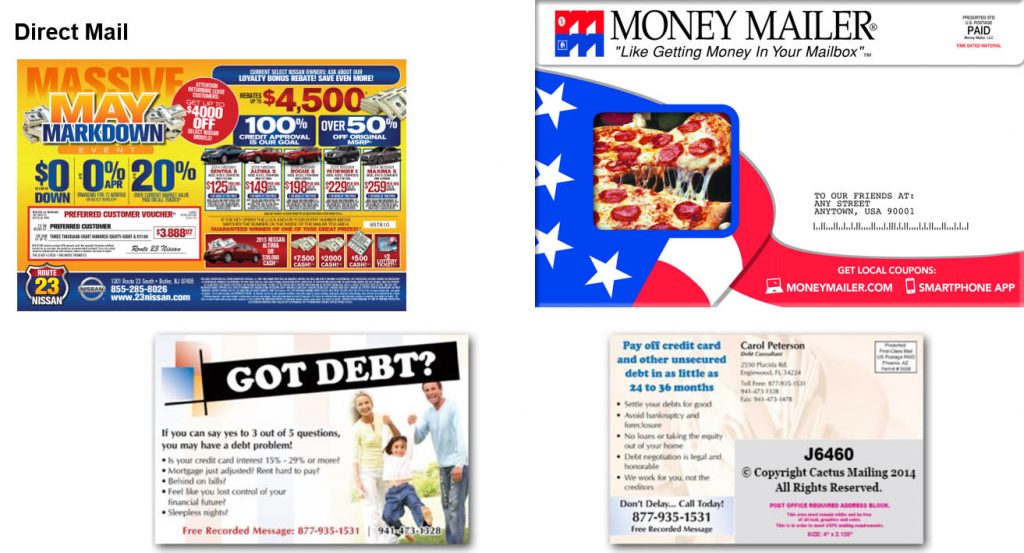
Directories
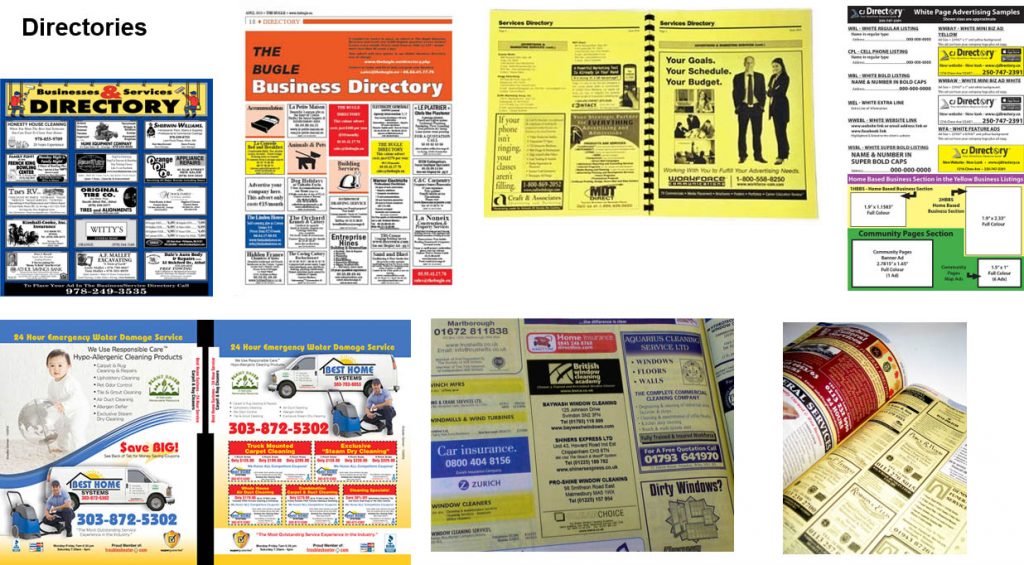
Local Publications
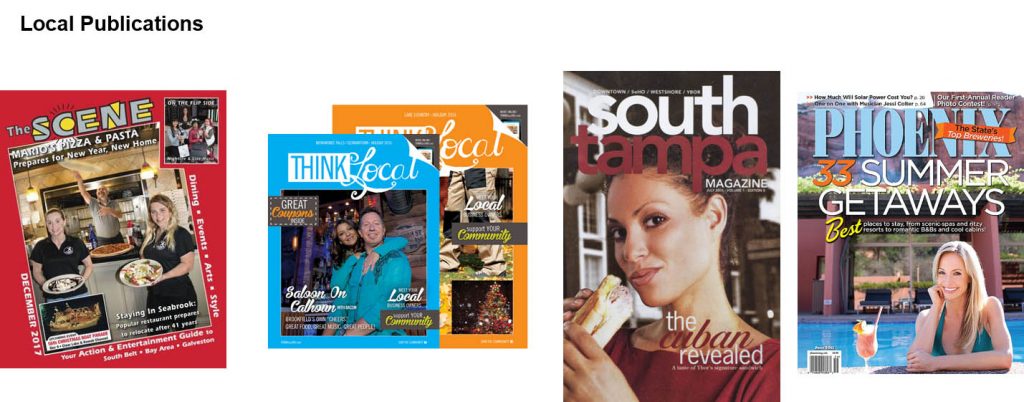
Magazines
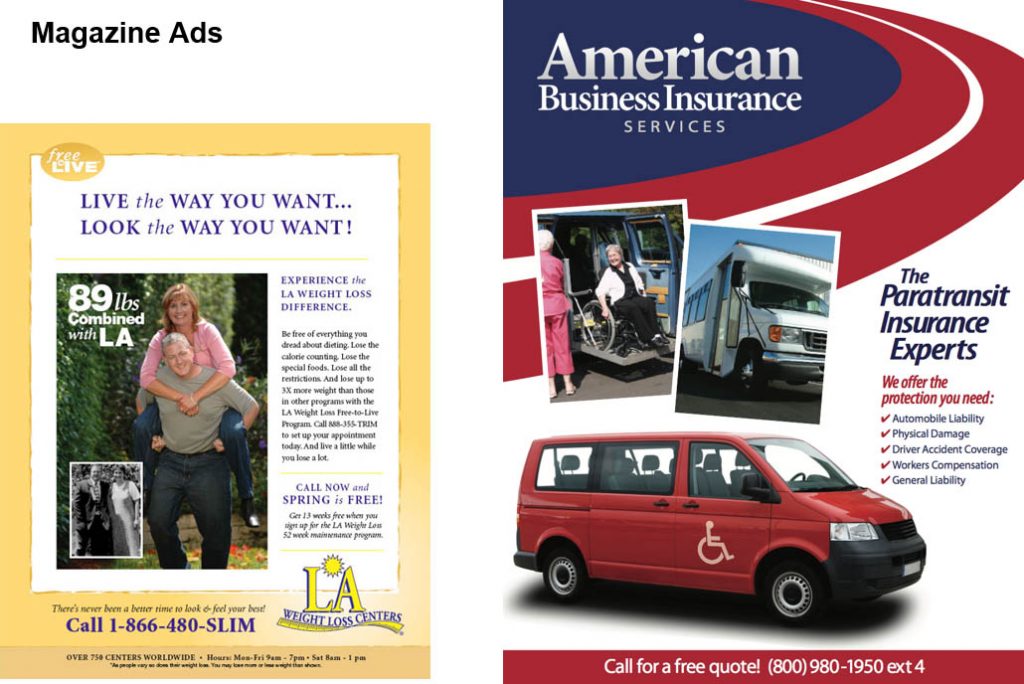
Newspapers – Ads
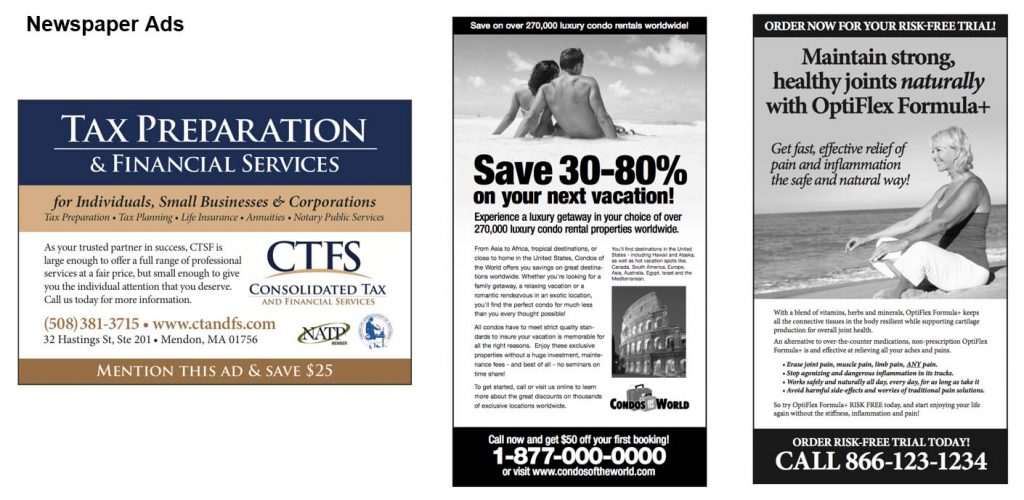
Newspapers – Classifieds
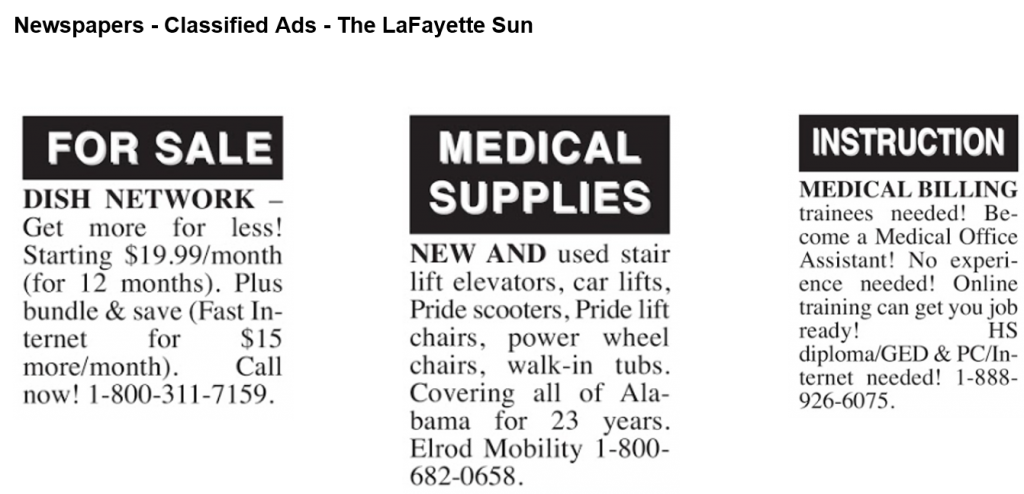
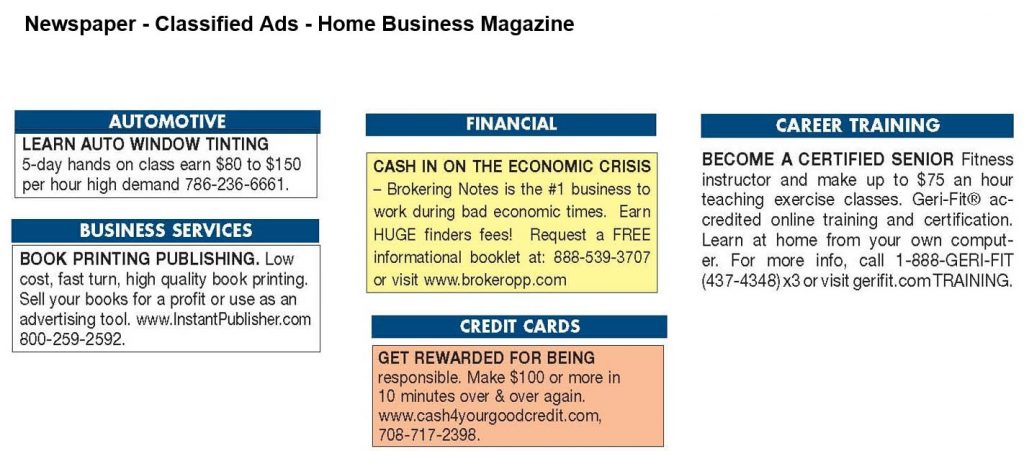
Specialty Publications
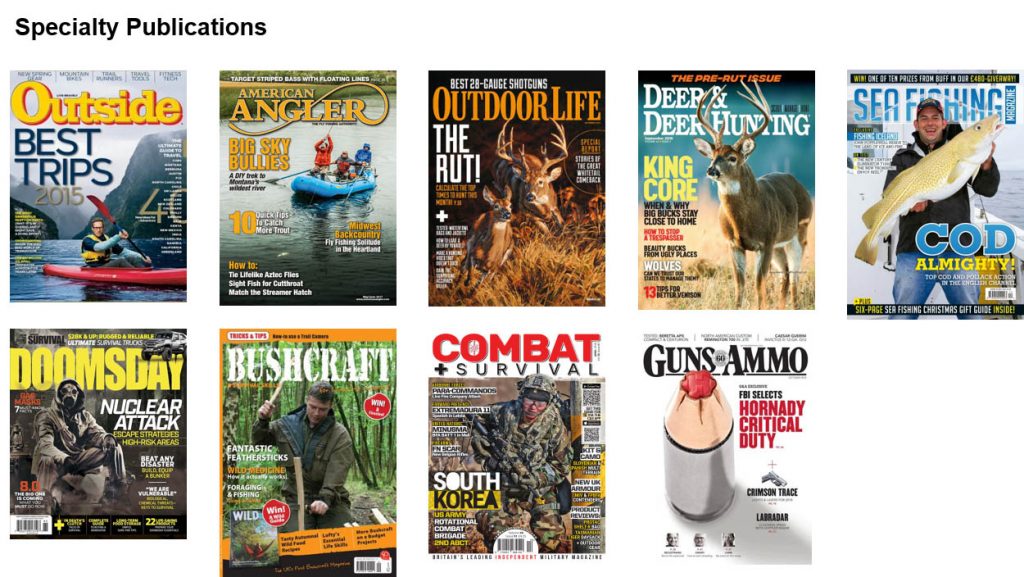
Trade Publications
